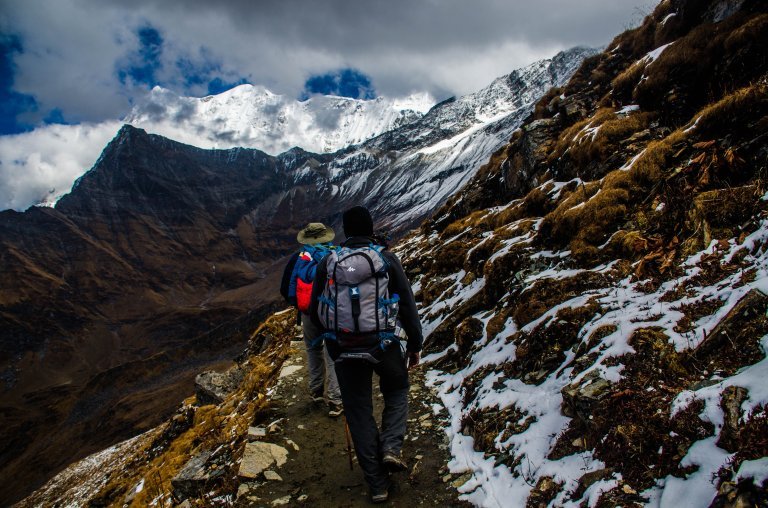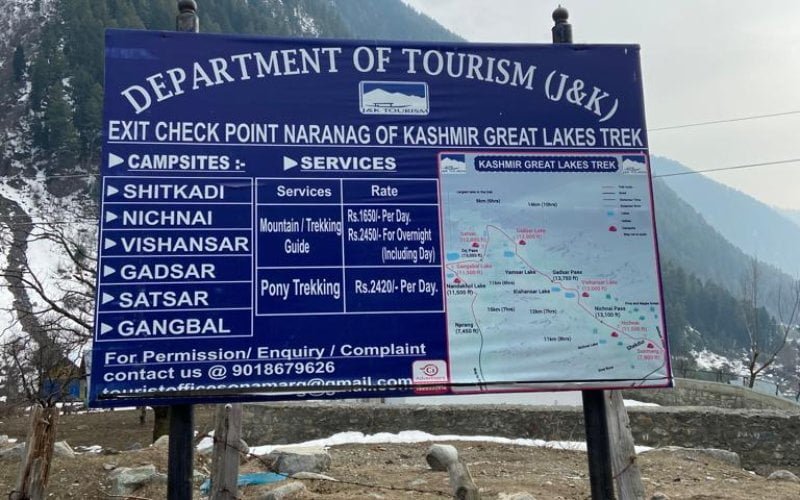The Great Lakes Trek is a wonderful and unique experience that takes you through the breathtaking landscapes of the Kashmir region in India. This trek stands out for its Beautiful alpine lakes, which add an enchanting element to the journey. Known as the “7 lakes of Kashmir Trek,” Which offers an out off the world experience of exploring Blue-green colored lakes Located amidst lush meadows and majestic mountains.
Table of Contents
ToggleThe trek begins in Sonamarg, and winds its way through dense jungles, meadows, and gullies, gradually ascending to higher altitudes. Each day brings new breathtaking views and natural wonders to discover.
To reach Kashmir, you have many options depending on your starting point:
It’s important to note that before planning your trip, you should check the current travel advisories and entry requirements for Jammu and Kashmir, as they may vary.


There are many Transportation options for Great Lake Trek in Kashmir depending upon the group size :
We provide Sedan with pickup form Srinagar Airport/ Railway Station to Sonamarg base camp.
We provide Innova/Taveera with pickup form Srinagar Airport/Railway Station to Sonamarg base camp
We provide Tempo Traveller with pickup form Srinagar Airport/Railway Station to Sonamarg base camp
We provide Bus with pickup form Srinagar Airport/Railway Station to Sonamarg base camp
For the Great Lakes Trek, pickup and drop-off services are included in the Great Lake trekking package. Here is a general overview of pickup and drop-off arrangements:
Airport Pickup: If you’re arriving by air, Our Taxi will be waiting for you outside Srinagar International Airport. You will be greeted by a representative who will transport you to the starting point of the trek in Sonamarg.
Hotel Pickup: If you’re already in Srinagar or staying at a hotel nearby, We will arrange a pickup from your accommodation and driver to pick you up and take you to Sonamarg.
Railway Station Pickup: If you’re arriving by Train, Our Taxi will be waiting for you outside Srinagar Srinagar Railway Station. You will be greeted by a representative who will transport you to the starting point of the trek in Sonamarg.
Trek Completion Point: At the end of the trek, usually in Naranag village, We will arrange for a drop-off back to Srinagar. A vehicle will be provided to transport you from Naranag to your desired location in Srinagar, such as your hotel or the airport.
Altitude: 7,800 ft – 3 hours drive
Altitude: 11,500 ft – 6 hours – 11.6 km
Altitude: 12,000 ft – 6 hours – 13.5 km
Altitude – 13,800 ft – 5 hours – 16 km
Altitude: 12,000 ft – 6 hours – 11.3 km
Altitude – 11,500 ft – 6 hours – 9 km
Altitude – 7,450 ft – 6 hours – 13 km
The customer receives a confirmation voucher via email within 24 hours of successful booking.
In case the preferred slots are unavailable, an alternate schedule of the customer’s preference will be arranged and a new confirmation voucher will be sent via email.
Alternatively, the customer may choose to cancel their booking before confirmation and a full refund will be processed.
The applicable refund amount will be processed within 10 business days.
Sonamarg, Jammu and Kashmir
For Group Booking , You can contact us on : +917051909192 via Call/Whatsapp
When preparing for the Great Lakes Trek, it’s important to pack essential items to ensure a safe and comfortable journey. Here are some things you should consider carrying:
1 Backpack: A sturdy and comfortable backpack to carry all your belongings. Make sure it has adjustable straps and offers proper support.
2.Clothing: Layered clothing appropriate for trekking in various weather conditions. Include quick-drying and moisture-wicking shirts, thermal wear, fleece jackets, waterproof and windproof outer layers, trekking pants, and comfortable underwear.
3.Footwear: Good quality trekking shoes with ankle support and a sturdy sole. Also, carry extra pairs of socks that are moisture-wicking to keep your feet dry.
4.Walking sticks: Optional but helpful for stability and reducing strain on your knees during steep ascents and descents.
5.Headlamp/Flashlight: Essential for navigating in low light conditions or during early morning or late evening hikes.
6.Snacks and Energy Bars: Carry lightweight and nutritious snacks like energy bars, nuts, dried fruits, and chocolates to keep your energy levels up during the trek.
7.Personal Hygiene Items: hand sanitizer, sunscreen, lip balm, and toilet paper. Also, bring a small towel for personal use.
8.Trekking Gear: Carry a lightweight and compact tent, sleeping mat, and cooking utensils if you plan on camping along the trek. Check with your trekking organizer if these items are provided or need to be arranged separately.
9. Extra Batteries and Chargers: Carry spare batteries and chargers for your electronic devices like cameras, smartphones, or GPS devices.
10.Cash and Identification: Carry sufficient cash in small denominations for emergencies. Keep your identification documents like passport, permits, and emergency contact information in a waterproof pouch.
It is crucial to be physically fit before embarking on the trek. Engage in regular exercise and activities that build endurance, strength, and flexibility. Prepare yourself for long hours of walking and challenging terrains.
Familiarize yourself with the trek route and carry a detailed map or a GPS device. Pay attention to the trail markers and signs along the way. If trekking with a group, stay together and follow the instructions of the trek leader or guide.
Stay hydrated throughout the trek by drinking an adequate amount of water. Carry water purification tablets or a filter to ensure a safe drinking supply. Pack nutritious snacks and meals that provide energy for the trek. Consider carrying some high-energy snacks like nuts, granola bars, and dry fruits.
Carry a basic first aid kit with essential supplies like bandages, antiseptic ointment, pain relievers, blister plasters, and any personal medications. Know basic first aid techniques and inform your trek leader or companions about any medical conditions or allergies you have.
Respect the environment and leave no trace of your presence. Dispose of waste properly and follow designated camping areas. Minimize your impact on nature by practicing responsible trekking ethics.
Interact respectfully with the local communities and adhere to their cultural norms and traditions. Learn about the local customs and practices before visiting any religious or sacred sites along the trek
Finally, remember to enjoy the trek and take in the breathtaking beauty of the Great Lakes region. Immerse yourself in the natural surroundings, capture memorable moments, and appreciate the adventure and serenity of the trek.
Camping in tents is the main accommodation choice. Along the trekking route, designated camping sites are available where twin sharing tents are set up. Camping lets you fully experience nature and appreciate the peacefulness of the surroundings.
When preparing for the Great Lakes trek, it is important to wear appropriate clothing to ensure comfort and safety throughout the journey. Here are some recommendations for what to wear:
Remember to pack lightweight and moisture-wicking clothing to minimize sweat and allow for better temperature regulation. It is advisable to consult with experienced trekkers or a local guide for specific clothing recommendations based on the season and weather conditions during your trek.
During the Great Lakes trek, you will have the opportunity to witness and experience a wide range of natural beauty and scenic landscapes. Here are some of the things you can expect to see during the trek:
Alpine Lakes: The Great Lakes trek is renowned for its stunning alpine lakes. You will come across several blue-green lakes, including Vishansar Lake, Kishansar Lake, Gadsar Lake, Satsar Lakes, Gangabal Lake, and Nundkol Lake.
Lush Meadows: As you trek through the valleys, you will encounter lush meadows adorned with vibrant wildflowers. These meadows present a carpet of colors, with various species of flowers in full bloom. The sight of these meadows against the backdrop of majestic mountains is truly worth remembring.
Snow-capped Peaks: The trek takes you through high-altitude regions where you will be treated to magnificent views of snow-capped peaks. Some prominent peaks you may see include Mount Harmukh, Kolahoi Peak, and the Thajwas mountain range.
Dense Forests: Throughout the trek, you will pass through dense forests consisting of a variety of trees, including pine, fir, and oak. These forests provide shade, shelter, and a rich biodiversity. Keep an eye out for unique flora and fauna that thrive in these forested areas.
Wildlife: The Great Lakes region is home to a wide range of wildlife. While trekking, you may encounter various species of birds, including colorful Himalayan monals, golden eagles, and Himalayan griffon vultures. If you’re lucky, you might spot other wildlife such as ibex, musk deer, or even the elusive snow leopard.
Local Villages and Culture: Along the trekking route, you may pass through local villages, offering a glimpse into the traditional mountain way of life. Interact with the locals, experience their hospitality, and get a taste of the local cuisine.

